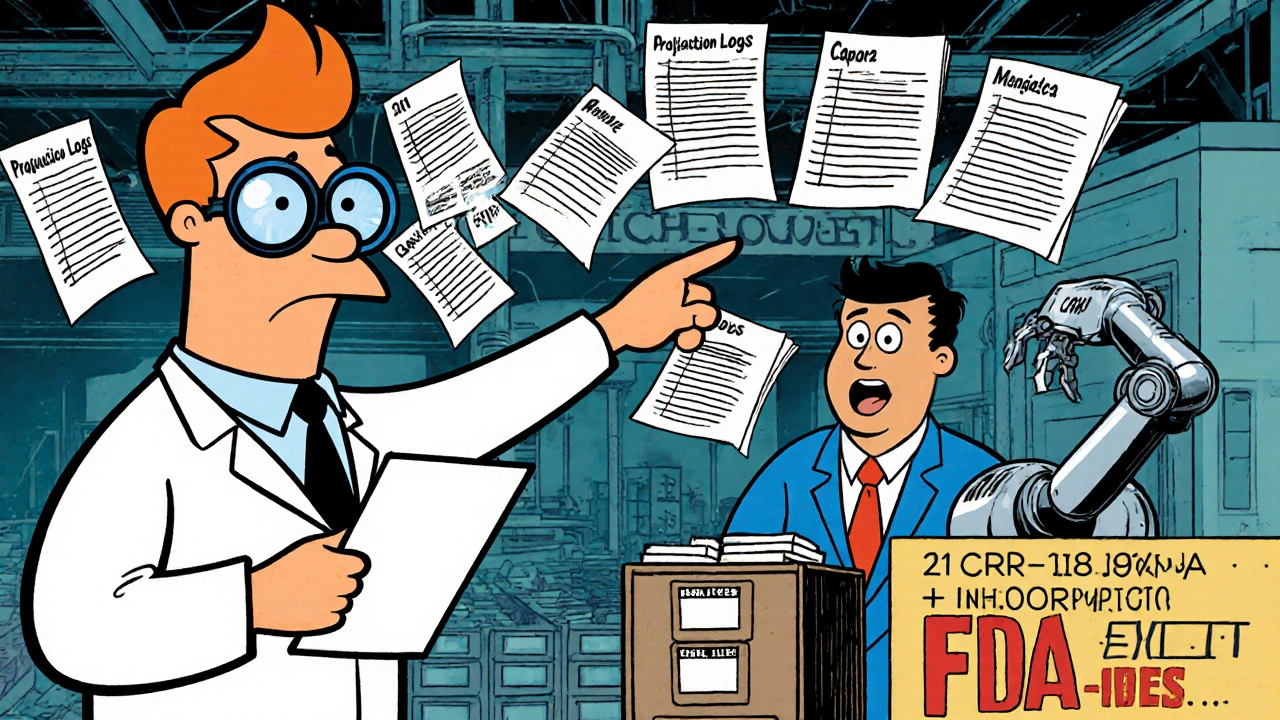When you take a pill, you assume it’s safe. But how do you know the factory that made it followed the rules? The answer lies in manufacturing transparency - and the FDA’s inspection records are the key.
What FDA inspection records actually show
The FDA doesn’t just show up at a drug factory and take a quick look. They dig deep. During an inspection, agents review production logs, equipment calibration records, batch testing results, and how the company handles mistakes. These aren’t just paperwork - they’re the paper trail of quality. If a batch of pills has too much or too little active ingredient, that’s recorded. If a machine wasn’t cleaned properly between runs, that’s documented. If someone ignored a deviation, that’s flagged. These records are required under 21 CFR 211.180, which says drug makers must keep them for at least one year after the product expires. For medical devices, it’s even longer - records must stay for the life of the device plus two years. The FDA doesn’t just ask for these documents. They demand them. And they’re legally required to be accurate, timely, and complete.What the FDA can and can’t see
Here’s where things get tricky. Not every internal report is fair game. The FDA has a clear policy, outlined in Compliance Policy Guide Sec. 130.300, that protects internal quality audits - the kind companies do to find their own problems before the FDA shows up. These are meant to be safe spaces where employees can speak honestly without fear of regulatory punishment. But here’s the line: if an internal audit finds a problem and the company investigates it as a quality control issue - like a contaminated batch or a failed test - that report is fair game. The FDA can and will ask for it. The difference? Internal audits are about prevention. Quality investigations are about fixing what went wrong. One is confidential. The other is mandatory. This distinction confuses even experienced quality teams. A 2025 survey of 47 pharmaceutical professionals found that 63% over-disclosed records because they couldn’t tell what was protected and what wasn’t. That’s costly. Handing over protected documents doesn’t help you - it can hurt you.How inspections actually work
There are two main types of FDA inspections: scheduled and unannounced. About 75% of inspections in 2024 were scheduled. That means the company knew the date. The other 25% were unannounced - inspectors showed up without warning. For foreign facilities, that number is rising fast. In 2023, only 12% of foreign inspections were unannounced. By the end of 2025, the FDA plans to hit 35%. When inspectors arrive, they start with Form FDA 482 - a notice that says, “We’re here to look at your records.” Then they dig. They check validation protocols for cleaning procedures. They pull deviation logs. They review CAPA (Corrective and Preventive Action) files. They look at training records. If they find issues, they issue Form FDA 483 - a list of observations. It’s not a fine. It’s not a shutdown. But it’s a warning. Companies have exactly 15 business days to respond. That’s not a suggestion. It’s a rule. The FDA expects a detailed root cause analysis, a plan to fix it, and proof it won’t happen again. Companies that follow this process close 89% of their Form 483 issues within six months. Those that don’t? Only 62% do.
What happens if you refuse access?
Refusing an FDA inspection is a serious offense. Section 301(f) of the Federal Food, Drug, and Cosmetic Act makes it illegal to deny, delay, or limit an inspection. In 2024, the FDA issued 17% more warning letters for inspection obstruction than the year before. Companies that block access risk product seizures, import alerts, or even criminal charges. Some manufacturers try to hide behind “trade secrets.” That doesn’t work. The FDA doesn’t need to know your proprietary formula. They need to know you’re making it safely. If your records show consistent failures - even if you’re using a secret process - you’re still in violation.Remote inspections are changing the game
In July 2025, the FDA finalized new rules for Remote Regulatory Assessments (RRAs). These aren’t full inspections. They’re virtual reviews. The FDA can ask for digital access to your quality system, review electronic records, or even do a live video walkthrough of your facility - all without stepping foot on-site. RRAs are faster, cheaper, and less disruptive. Companies using them cut inspection-related downtime by 65%. By Q1 2025, 73% of Fortune 500 pharma companies had built RRA-ready systems. That’s not a trend - it’s the new baseline. But RRAs can’t replace physical inspections for high-risk facilities. The FDA still needs to see the floors, the machines, the hands on the controls. That’s why unannounced visits are increasing. The agency is using RRAs to triage - identifying which sites need a real inspection, and which can be monitored remotely.
Why transparency matters - and why it’s under pressure
The FDA’s goal isn’t to catch companies breaking rules. It’s to prevent harm. A 2024 GAO report found that foreign facilities with poor inspection histories were more likely to ship contaminated products. That’s why the agency is pushing harder for access - especially overseas. But there’s pushback. The pharmaceutical industry argues that too much transparency kills internal honesty. If every audit is fair game, companies won’t dig deep. Dr. Jane Axelrad, former FDA deputy director, says the protected audit policy “creates a safe space for meaningful improvement.” Meanwhile, Congress is moving toward mandatory public disclosure of inspection results. The 2024 Pharmaceutical Supply Chain Transparency Act (S. 2884) would force the FDA to publish findings online. The industry opposes it. They say it could scare off honest reporting. The FDA hasn’t taken a public stance yet - but they’re watching.What manufacturers need to do now
If you’re in manufacturing, here’s what you need to get right:- Separate internal audits from quality investigations. Use different file systems. Label them clearly.
- Train your team on what’s protected and what’s not. The confusion is real - and costly.
- Build an RRA-ready system. Digital records, secure access, audit trails. This isn’t optional anymore.
- Prepare for unannounced inspections. Have your records organized, your staff trained, your response team on standby.
- Never delay or deny access. The FDA will find out. And they’ll act.
Bottom line: Transparency isn’t optional
Manufacturing transparency isn’t about pleasing regulators. It’s about protecting patients. The FDA’s access to records isn’t a power grab - it’s a safety net. And as inspections become more frequent, more remote, and more unpredictable, the companies that thrive won’t be the ones with the best lawyers. They’ll be the ones with the best systems - honest, accurate, and ready for anything.There’s no shortcut. No loophole. Just clean records, clear processes, and the discipline to keep them that way.
Can the FDA inspect my facility without warning?
Yes. The FDA can conduct unannounced inspections, especially at foreign facilities. In 2023, only 12% of foreign inspections were unannounced. By the end of 2025, that number will rise to 35%. Domestic facilities are mostly scheduled, but the FDA retains the right to show up anytime.
What records must I give the FDA during an inspection?
You must provide all current Good Manufacturing Practice (CGMP) records, including production and control records, validation protocols, deviation reports, CAPA documentation, and quality control investigations. Records must be retained for at least one year after product expiration (21 CFR 211.180).
Are internal quality audits protected from FDA review?
Yes - but only if they’re part of a formal internal quality assurance program under CPG Sec. 130.300. The FDA generally won’t request these. However, if an internal audit leads to a formal quality investigation of a product failure, that investigation record must be provided.
What is Form FDA 483 and how do I respond?
Form FDA 483 lists observations made during an inspection. It’s not a citation, but it’s serious. You have exactly 15 business days to respond with a root cause analysis, corrective actions, and preventive steps. Following the FDA’s recommended methodology, companies close 89% of these issues within six months.
Can the FDA inspect medical device manufacturers the same way as drug makers?
Yes. Medical device manufacturers are subject to the Quality System Regulation (21 CFR Part 820), which requires similar recordkeeping. Records must be kept for the device’s lifespan plus two years. The FDA uses the same inspection tools - Form 482, Form 483, and CAPA reviews - across both drug and device facilities.
What are Remote Regulatory Assessments (RRAs)?
RRAs are virtual evaluations authorized by FDA guidance finalized in July 2025. They allow inspectors to review electronic records, conduct video walkthroughs, or request read-only access to digital systems. RRAs don’t replace physical inspections but can reduce them. Companies using RRAs cut inspection downtime by 65%.
What happens if I don’t respond to a Form 483?
Failure to respond within 15 business days can trigger further FDA action, including warning letters, import alerts, or even product seizures. The FDA considers non-response as a sign of poor quality culture. In 2024, 22% of warning letters cited failure to provide timely or adequate responses.
Do I need to keep paper records or are digital records okay?
Digital records are fully acceptable as long as they’re secure, tamper-proof, and meet FDA’s requirement for contemporaneous documentation. The FDA issued a warning letter in 2024 to a company that backdated electronic entries - proving that digital doesn’t mean less scrutiny.






Chrisna Bronkhorst
November 10, 2025 AT 22:48Let’s cut the fluff. The FDA doesn’t care about your internal audits. They want blood. If your CAPA log looks like a fairy tale, they’ll shut you down. No warnings. No mercy. Just a Form 483 and a one-way ticket to import alert hell.
Eve Miller
November 11, 2025 AT 11:00You’re missing the point entirely. The FDA’s authority isn’t arbitrary-it’s codified in 21 CFR 211.180 and 820.30. Internal audits are protected under CPG 130.300 precisely because accountability requires psychological safety. If you conflate prevention with punishment, you’re not protecting patients-you’re enabling fear-driven compliance.
And yes, digital records are acceptable, but only if they’re validated, auditable, and timestamped with cryptographic integrity. Backdating electronic entries? That’s not negligence. That’s fraud.
Companies that treat RRAs as a loophole are already failing. Remote assessments are triage tools, not replacements. The FDA isn’t lazy-they’re strategic. They’re using data to target the high-risk facilities that actually endanger lives.
And before you say ‘trade secrets,’ remember: the FDA doesn’t need your formula. They need to know you didn’t mix aspirin with fentanyl because your technician was tired. That’s not paranoia. That’s pharmacology.
Transparency isn’t a burden. It’s the only thing standing between a child and a lethal batch. If you’re complaining about paperwork, you shouldn’t be in pharma.
Amie Wilde
November 12, 2025 AT 22:35They can show up anytime. Just be ready.
Gary Hattis
November 14, 2025 AT 17:39Look, I’ve worked in plants in India, Mexico, and now Ohio. The FDA’s rules don’t change based on location-but the way people react to them does. In the U.S., everyone panics and over-documents. In developing countries, they under-doc and hope for the best. Neither works.
The real win? Companies that treat inspections like audits from their own board. Not as a threat. As feedback. That’s how you build culture, not just compliance.
And RRAs? They’re the future. Why waste two weeks shuttling inspectors across the globe when you can share your digital system in a secure portal? The FDA’s not trying to spy. They’re trying to save time-so they can focus on the plants that actually need help.
Also, if your team doesn’t know the difference between an internal audit and a quality investigation, you’ve got bigger problems than the FDA.
Erica Cruz
November 16, 2025 AT 05:40Of course the FDA wants public records. It’s not about safety-it’s about control. They’ve been pushing this since 2020. Now they’re using ‘patient safety’ as a cover to force companies into digital submission traps. You think your trade secrets are safe? They’re not. Once it’s digital, it’s theirs.
And let’s be real: 89% closure rate? That’s PR spin. Most companies just write a generic response, pay a consultant, and move on. The FDA knows it. They just don’t care. They’ve got their metrics.
Meanwhile, the real issue? The FDA’s own inspectors are undertrained and overworked. They’re flying in from DC with no industry experience, reading your logs like they’re novels. And you’re supposed to trust them to spot a deviation? Please.
Deepa Lakshminarasimhan
November 17, 2025 AT 10:51Ever wonder why the FDA suddenly cares about foreign plants? Coincidence that China’s pharma exports are rising? Or that the U.S. is losing its drug manufacturing edge? This isn’t about safety. It’s about control. They’re using inspections to pressure companies into offshoring less. They want you to make pills in America-even if it costs 5x more.
And RRAs? That’s just the first step. Next thing you know, they’ll be demanding live feeds from your cleanrooms. They’ll have AI scanning your logs for ‘suspicious patterns.’ You think your employees are safe reporting mistakes? They’re not. Once it’s digital, it’s traceable. And traceable means punishable.
They’re building a surveillance state under the guise of ‘patient safety.’ Don’t be fooled. The real goal? Monopolize the supply chain. And if you don’t comply? You’re labeled ‘non-compliant’ and pushed out. Game over.
Johnson Abraham
November 17, 2025 AT 17:11bro the fda is just a bunch of bureaucrats who read too many policy docs. they dont even know what a capa is. i saw one inspector ask for a ‘deviation log’ and then say ‘wait… is this like a spreadsheet?’ lol. why are we all sweating over this? just make sure the pills dont look weird. thats it.
and rrAs? more like rras (really random ass stuff). they want to video call your factory? cool. now they know where you keep the coffee machine. who cares.
if they want records, give em the bare minimum. dont overthink it. they’ll forget about you by next quarter. trust me. i’ve been in this game 15 years.
Esperanza Decor
November 18, 2025 AT 03:36I’ve seen companies spend $2M on compliance systems only to have a single typo on a batch record trigger a 6-month shutdown. The system isn’t broken-it’s overengineered. The FDA doesn’t need every email, every Slack message, every ‘what if’ scenario documented. They need to know the product is safe.
And yet, we’re drowning in paperwork because someone in legal got scared after a 2018 warning letter. We’re training engineers to be archivists, not problem-solvers.
What if we flipped the script? Instead of demanding every deviation be logged, what if we focused on the top 5 critical controls that actually impact safety? Let the rest be culture, not compliance.
RRAs are a gift if you’re ready. But if your quality system is a mess of Excel sheets and handwritten logs, you’re not ready. You’re just lucky.
And for the love of God, stop treating internal audits like they’re court evidence. If your team can’t speak honestly because they’re afraid of the FDA, you’ve already lost.
Transparency isn’t about sharing everything. It’s about sharing what matters. And right now, we’re sharing too much of nothing.